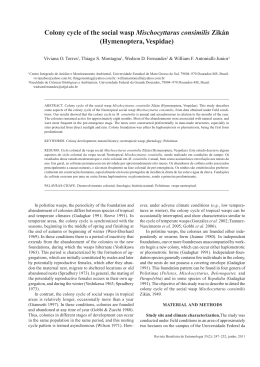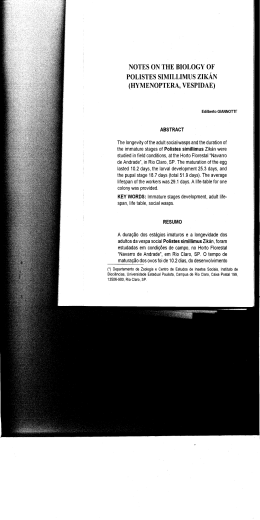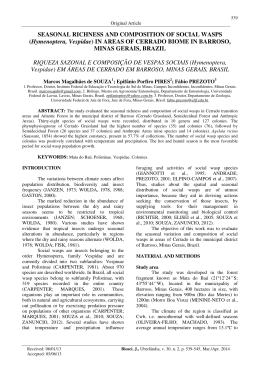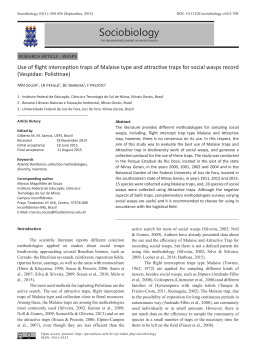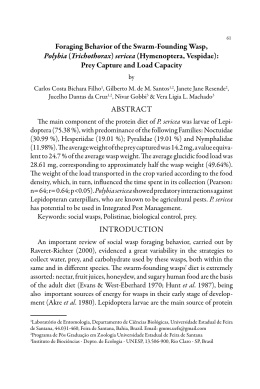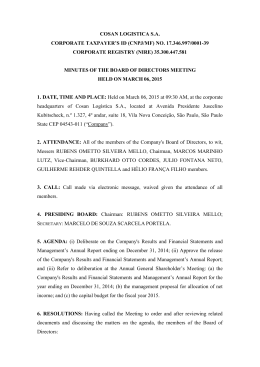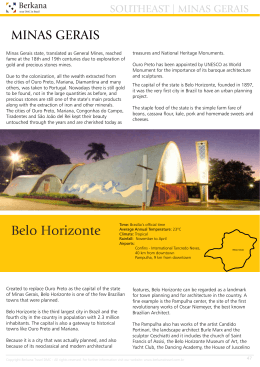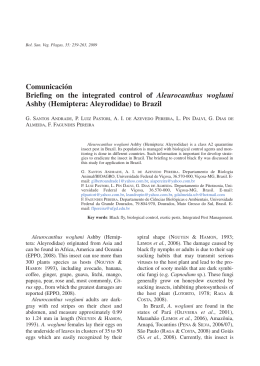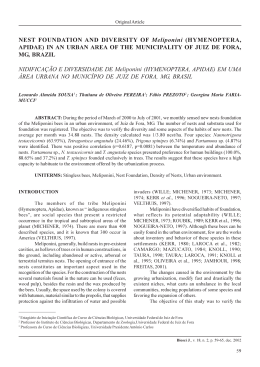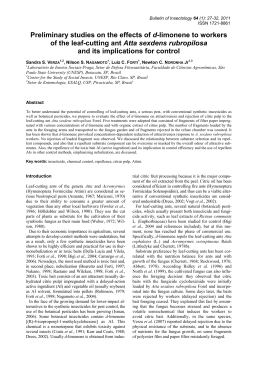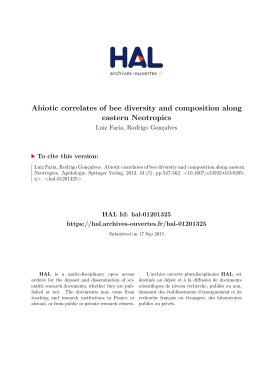Sociobiology 62(3): 439-445 (September, 2015) DOI: 10.13102/sociobiology.v62i3.738 Sociobiology An international journal on social insects RESEARCH ARTICLE - WASPS Diversity of Social Wasps (Hymenoptera: Vespidae: Polistinae) in an Agricultural Environment in Bambuí, Minas Gerais, Brazil GC Jacques1,2, MM Souza3, HJ Coelho1, LO Vicente1, LCP Silveira2 1 - Instituto Federal de Educação, Ciência e Tecnologia de Minas Gerais, Bambuí, MG, Brazil 2 - Universidade Federal de Lavras, Lavras, MG, Brazil 3 - Instituto Federal de Educação, Ciência e Tecnologia do Sul de Minas, Inconfidentes, MG, Brazil Article History Edited by Fernando Barbosa Noll, UNESP, Brazil Received 29 December 2014 Initial acceptance 08 March 2015 Final acceptance 26 May 2015 Keywords Biodiversity, Polistes versicolor, Polistinae. Corresponding author Gabriel de Castro Jacques Departamento de Entomologia Universidade Federal de Lavras 37200-000, Lavras-MG, Brazil E-Mail: [email protected] Abstract Studies on the diversity of social wasps in agricultural environments represent an important step to identify ideal species to be used in biological pest control programs. There is a growing effort to recognize the diversity of these insects, but information on anthropized environments is still rare. This study focused on obtaining data on the diversity of social wasps in a predominantly agricultural area in Bambuí, Minas Gerais, Brazil, and identifying, through dominance, species with potential use in biological control studies. Sampling was conducted from July 2012 to July 2014 with two type of wasps’ capture methods: attractive traps and active search. This research confirms that a well diversified environment, even if anthropized, is rich in social wasp species. In addition, the great number of collected species shows the importance of a long-term survey and the use of more than one method of capture. The high rate of collections of Polistes versicolor in a predominantly agricultural environment, coupled with other studies on this species as a predator of lepidopteran caterpillars, suggests the use of this species as a tool in biological control of pests. Introduction Social wasps (Vespidae) are insects belonging to the order Hymenoptera, and may play an important ecological role in the environment, acting as pollinators (Hunt, 1991; Brodmann, 2008; Mello et al., 2011) and predators (Prezoto & Machado, 1999; Prezoto et al., 2006; Silveira et al., 2008; Gomes & Noll, 2009). This family includes solitary species (Euparigiinae, Masarinae and Eumeninae), and others with different degree of sociality (Stenogastrinae, Polistinae and Vespinae) (Carpenter, 1993; Carpenter & Marques, 2001). In this family, those wasps belonging to the subfamily Polistinae are eusocial, cosmopolitan and highly diverse in the Neotropical region (Carpenter et al., 1996; Carpenter & Marques, 2001; Silveira, 2002). Brazilian species of Polistinae belong to three tribes, namely Polistini, Mischocyttarini and Epiponini, with 23 genus e 319 species (Carpenter & Marques, 2001). The survival of these social wasps depends on their success in creating new colonies (Dejean et al, 1998; Hunt, 2007). The choice for a nesting site depends on certain morphological characteristics, such as protection from rain and predators (e.g., ants and vertebrates), besides proximity to food resources and material for nest construction (Andena et al., 2009; Santos et al., 2010; Souza et al., 2010; Souza et al. 2014a). Disturbances caused by humans in natural environments are the main factors which may reduce their biodiversity (Samways, 2007). Social wasps act as pollinators (Suhs et al., 2009) and the extinction of a pollinator can cause loss of plant species and trigger a “cascade of linked extinctions” (Myers, 1986). Some Hymenoptera species are sensitive to variations of abiotic conditions (light, temperature and humidity), which may be related to changes in the level of environment degradation, thus representing potential environmental indicators (Souza et al., 2010). Open access journal: http://periodicos.uefs.br/ojs/index.php/sociobiology ISSN: 0361-6525 440 Biological inventories are the first step for the development of preservation studies, since it is essential to know first of all which resources are available in a particular area (Elpino-Campos et al., 2007). Social wasps are easily sampled because they forage and return to a core area (nest). The survey and identification of these insects, especially in predominantly agricultural environments, are the first steps to identify ideal species to use in biological control of pests programs (Prezoto et al., 2006). Several studies have been developed on the diversity of species of social wasps in Brazil, however, most of them focused only natural environments (Silveira, 2002; Silva-Pereira & Santos, 2006; Souza & Prezoto, 2006; Elpino-Campos et al., 2007; Santos et al. 2007; Silveira et al., 2008; Gomes & Noll, 2009; Silva & Silveira, 2009; Santos et al., 2009; Souza et al., 2010; Bonfim & Antonialli Junior, 2012; Simões et al., 2012; Souza et al., 2012; Grandinete & Noll, 2013; Locher et al. 2014; Souza et al., 2014a, 2014b). Therefore, the fauna of wasps in anthropized environments is still poorly known (Jacques et al., 2012). The objective of this study was to obtain data on the diversity of social wasps in a predominantly agricultural area, Instituto Federal de Educação, Ciências e Tecnologia de Minas Gerais (IFMG), Campus Bambuí, Minas Gerais, Brazil, and to identify, through dominance, species with potential for use in biological control studies. Material and Methods This research was conducted at the Instituto Federal de Educação, Ciência e Tecnologia de Minas Gerais (IFMG), campus Bambuí, Minas Gerais, Brazil. The campus has a total area of 328 ha, with one anthropic site, but very diverse, with a predominance of buildings and agricultural areas. An area with 175 hectares is used for agricultural crops (corn, beans, sugar cane, orange, banana, coffee and vegetables) and pastures, and 34 acres of buildings, most being close to the cultivated areas. Sampling was conducted in agricultural environments from July 2012 to July 2014 with two types of sampling techniques: attractive traps and active search. The traps were made with two-liter plastic soft-drink bottles, with three triangular lateral openings (2 x 2 x 2 cm) at a 10 cm distance from the base (Souza & Prezoto, 2006). Substances used to attract insects were: 1- natural passion fruit juice (Passiflora edulis f. flavicarpa Deg. - Passifloraceae) prepared with 1 kg of fruit blended with 250g granulated sugar plus two liters of water; 2- sardine broth (Sardinella brasiliensis Steindachner 1789), which included two cans of sardines plus two liters of water; 3- pure honey; 4 - sugarcane molasses diluted to 50%. Five bottles with 150 ml attractive substance for each type of bait, were assembled in eight dates, with total for forty bottles per attractive substance type (160 traps in total). These traps were set up next to the cultivars at the IFMG campus, at a 1.5 m height above the ground. The traps were active for GC Jacques et al - Diversity of Social Wasps in Agricultural Environments seven days. After that time, the wasps collected were removed and preserved in 70% alcohol for later identification. Active searches were conducted throughout the agricultural area of the campus Bambuí at the IFMG. Trunks of trees and other natural cavities, broad-leaved vegetation, flowers and edifications were surveyed and the wasps were collected with the aid of entomological nets (Souza & Prezoto, 2006; Elpino-Campos et al., 2007). Species collected were identified using entomological keys (Richards, 1978; Carpenter, 2004). Diversity was calculated by the Shannon-Wiener (H‘) index, and the dominance by the Berger-Parker index (DPB), through the DivEs program - Diversity of Species v3.0.3, in the base 10 logarithmic (Rodrigues, 2014). Results and Discussion Five hundred and twenty-seven social wasps of 8 genus and 29 species were collected, with a total diversity index of 1.7406 (Table 1). This great richness of species, compared with that observed by other authors (Table 2), is explained by the fact that many species of social wasps present high level of synanthropism (Fowler, 1983; Michulleti et al, 2013). The study area has a very diverse environment, which may help explain the large number of species collected, since environments that are structurally more heterogeneous and complex may favor the coexistence of a larger number of species due to the greater availability of microhabitats, greater protection against predators and greater disposal and diversity of food resources and substrate for nidification (Santos et al, 2007; Souza et al, 2012). There was high dominance (Dpb= 0.2789) of few species. Polistes versicolor (Olivier, 1791) presented the greater rate of total frequency (36.81%), it has been collected 194 times. It also had the higher frequency in capture by attractive traps (34.35%) and active search (47.47%). Such occurrence may be explained by the fact that there are P. versicolor nests in both urban buildings and vegetation (Oliveira et al., 2010; Torres et al., 2014a), which makes it easy to be found. Wasps of Polistes are excellent predators of agricultural pests, especially caterpillars of Lepidoptera (Prezoto et al., 2006; Elisei et al., 2010; Souza et al., 2013). Thus, the agrarian environment of the campus may have provided a favorable environment for P. versicolor, because the caterpillars present in different agricultural areas are the main feed of immature insects that develop in the colony (Raveret-Richter, 2000). In 120 hours of observation, 315 returns of P. versicolor foragers included preys, mostly lepidopteran caterpillars (Elisei et al., 2010). Eighty-nine preys (95% of Lepidoptera) were captured by this species in Juiz de Fora, MG (Prezoto et al., 2006). The predatory activity of this wasp was also studied on Chlosyne lacinia saundersii (Doubleday & Hewitson, 1849) (Lepidoptera: Nymphalidae) (Campos-Farinha & Sociobiology 62(3): 439-445 (September, 2015) 441 Table 1. Richness, diversity and dominance of social wasp species collected at the Instituto Federal de Educação, Ciência e Tecnologia de Minas Gerais (IFMG), Campus Bambuí, Minas Gerais, Brazil. September, 2014. Active search Species Traps Total Abundance Frequency relative (%) Abundance Frequency relative (%) Abundance Frequency relative (%) 1 Agelaia centralis (Cameron, 1907) 1 1.01% 127 29.67% 128 24.29% 2 Agelaia multipicta (Haliday, 1836) 1 1.01% 47 10.98% 48 9.11% 3 Apoica gelida Van der Vecht, 1973 0 0.00% 2 0.47% 2 0.38% 4 Brachygastra lecheguana (Latreille, 1824) 1 1.01% 2 0.47% 3 0.57% 5 Mischocyttarus bahiae Richards, 1949 1 1.01% 0 0.00% 1 0.19% 6 Mischocyttarus cassununga (R. Von. Ihering, 1903) 2 2.02% 3 0.70% 5 0.95% 7 Mischocyttarus cerberus (Richards, 1940) 1 1.01% 1 0.23% 2 0.38% 8 Mischocyttarus drewseni Sausurre, 1857 2 2.02% 2 0.47% 4 0.76% 9 Mischocyttarus ignotus Zikán, 1949 3 3.03% 0 0.00% 3 0.57% 10 Mischocyttarus latior (Fox, 1898) 1 1.01% 0 0.00% 1 0.19% 11 Mischocyttarus matogrossensis Zikán, 1935 1 1.01% 0 0.00% 1 0.19% 12 Mischocyttarus nomurae Richards, 1978 1 1.01% 0 0.00% 1 0.19% 13 Mischocyttarus paraguayensis Zikán, 1935 6 6.06% 0 0.00% 6 1.14% 14 Mischocyttarus rotundicolis (Cameron, 1912) 12 12.12% 1 0.23% 13 2.47% 15 Polistes actaeon Haliday, 1836 1 1.01% 0 0.00% 1 0.19% 16 Polistes satan Bequaert, 1940 3 3.03% 8 1.87% 11 2.09% 17 Polistes simillimus Zikán, 1951 2 2.02% 21 4.91% 23 4.36% 18 Polistes versicolor (Olivier, 1971) 47 47.47% 147 34.35% 194 36.81% 19 Polybia bifasciata Saussure, 1854 1 1.01% 0 0.00% 1 0.19% 20 Polybia chrysothorax (Lichtenstein, 1796) 1 1.01% 12 2.80% 13 2.47% 21 Polybia erythrothorax (Richards, 1978) 2 2.02% 0 0.00% 2 0.38% 22 Polybia ignobilis (Haliday, 1836) 0 0.00% 25 5.84% 25 4.74% 23 Polybia jurinei Saussure, 1854 0 0.00% 18 4.21% 18 3.42% 24 Polybia occidentalis (Olivier, 1971) 2 2.02% 2 0.47% 4 0.76% 25 Polybia paulista (R. Von. Ihering, 1896) 4 4.04% 0 0.00% 4 0.76% 26 Polybia rejecta (Fabricius, 1978) 1 1.01% 0 0.00% 1 0.19% 27 Polybia sericea (Olivier, 1971) 0 0.00% 10 2.34% 10 1.90% 28 Protopobybia sedula (Saussure, 1854) 1 1.01% 0 0.00% 1 0.19% 29 Synoeca cyanea (Fabricius, 1775) 1 1.01% 0 0.00% 1 0.19% Total of individuals 99 428 527 Richness of species (S`) 25 16 29 Shannon-Wiener (H`) Index 0,9402 0,8004 1,7406 Berger-Parker (Dpb) Index 0,4747 0,3435 0,2789 GC Jacques et al - Diversity of Social Wasps in Agricultural Environments 442 Pinto, 1996) and on Heraclides anchysiades capys (Hübner, 1809) (Lepidoptera: Papilionidae) (Marques, 1996, 2005). Moreover, the presence of wasps of the genus Polistes in different cultures is associated with reduced damage caused by pests on cotton (Kirkton, 1970), tobacco (Lawson et al., 1961), cabbage (Gould & Jeanne, 1984), coffee (Gravena, 1983) and corn (Prezoto & Machado, 1999), showing the importance of this genus for studies on the biological control of pests. Table 2. Comparison between the total number of species in this research work (*) and other surveys in the literature. Researches Number of species Silveira, 2002 (Amazon Rainforest) 79 Silva & Silveira, 2009 (Amazon Rainforest) 65 Souza et al., 2014a (Cerrado) 38 Souza et al., 2012 (Atlantic Forest) 38 Souza & Prezoto, 2006 (Cerrado and Semidecidual Forest) 38 Souza et al., 2010 (Riparian) 36 Simões et al., 2012 (Cerrado) 32 Locher et al., 2014 (Riparian Vegetation) 31 *Present work (Agricultural Environment) 29 Elpino-Campos et al., 2007 (Cerrado) 29 Souza et al., 2014b (Riparian) 28 Jacques et al., 2012 (Anthropized environment) 26 Grandinete & Noll, 2013 (Cerrado) 22 Santos et al., 2009 (Cerrado) 19 Bonfim & Antonialli Junior, 2012 (Riparian Vegetation) 18 Santos et al., 2007 (Atlantic Forest) 18 Santos et al., 2007 (Restinga Vegetation) 16 Silva-Pereira & Santos, 2006 (Campos Rupestres) 11 Arab et al., 2010 (Atlantic Forest) 10 Santos et al., 2007 (Mangrove) 8 Gomes & Noll, 2009 (Semidecidual Forest) 7 Agelaia centralis (Cameron, 1907) and Agelaia multipicta (Haliday, 1836) also showed high frequency in the community in collections using attractive traps (29.67% and 10.98%, respectively). Some species of genus Agelaia Lepeletier, 1836 can build colonies with a population estimated in up to a million of adults (Zucchi et al., 1995), which means a greater ability of foraging by a greater amount of wasps and increased chances of finding specimen of this group (Hunt et al., 2001). Furthermore, these wasps have a scavenger habit, especially being collected by the attractive sardine broth, which is used as an additional source of protein for their larvae (Prezoto & Souza, 2006). The high prevalence of this genus was also reported in different ecossystems in Brazil (Gomes & Noll, 2009; Arab et al., 2010; Grandinete & Noll, 2013; Locher et al., 2014). The most collected genus was Mischocyttarus De Saussure, 1853, with 10 species, and Mischocyttarus bahiae Richards, 1949 was first recorded for the state of Minas Gerais, which shows the importance of surveys on social wasp richness and diversity. Nests of Mischocyttarus are easily found in edifications, making it easy to locate it (Alvarenga et al., 2010). Moreover, this genus consists of the largest group of social wasps, with 245 species of eleven subgenera, which added to fact that only a few have been studied for richness and diversity, increases the chance of unpublished records (Cooper, 1998; Silveira, 2008). Of the 28 species found, 25 were located in their colonies. This was due to the long period of data collection, which is important, because collection must be carried out in the warmer and wetter periods of the year, considering that there is a positive correlation between these abiotic factors and the number of species and colonies (Souza et al., 2014a). This is due to a greater availability of nesting sites, protection from predators and increased availability and diversity of food resources on those periods (Prezoto et al., 2006; ElpinoCampos et al., 2007). The methodology of active search, considering the richness of the collected species, was more effective than the use of traps (Table 1), whereas sixteen species were collected solely through this method. This has also been observed in other works (Silveira, 2002; Souza & Prezoto, 2006; ElpinoCampos et al., 2007; Jacques et al., 2012; Loucher et al., 2014; Souza et al., 2014b). Four species, Apoica gelida Van der Vecht, 1973, Polybia ignobilis (Haliday, 1836), Polybia jurinei Saussure, 1854 and Polybia sericea (Olivier, 1971), were collected solely through traps. This may be related to the fact that social species have the habit of nesting in one place and feeding in another (Pereira & Santos, 2006). Furthermore, the genus Apoica Lepeletier, 1836 are generally captured by traps, because they mainly forage at night (Hunt et al., 1995; Pickett & Wenzel, 2007), making it less likely to be captured by active search during the day. These results demonstrate the importance of using more than one method to record the highest possible number of wasp species (Jacques et al., 2012). This work confirms that a well-diversified environment, even if anthropized, such as the Campus Bambuí of the Instituto Federal de Educação, Ciência e Tecnologia de Minas Gerais (IFMG), Brazil, includes a rich amount of species of social wasps. In addition, the great number of collected species, shows the importance of a long-term survey and the use of more than one method of collection. The high rate of collections of Polistes versicolor in a predominantly agricultural environment, coupled with other studies on this species as a predator of lepidopteran caterpillars, suggests the use of this species as a tool in the biological control of pests. Sociobiology 62(3): 439-445 (September, 2015) Acknowledgments We thank to the Instituto Federal de Educação, Ciência e Tecnologia de Minas Gerais (IFMG) – Campus Bambuí, for granting a trainee scholarship; and the Conselho Nacional de Desenvolvimento Científico e Tecnológico (CNPq) for granting a PhD scholarship. References Alvarenga, R.B., Castro, M.M., Santos-Prezoto, E.H. & Prezoto, F. (2010). Nesting of social wasps (Hymenoptera, Vespidae) in urban gardens in southeastern Brazil. Sociobiology, 55: 445-452. Andena, R.B., Carpenter, J.M. & Pickett, K.M. (2009). Phylogenetic analysis of species of the Neotropical social wasp Epipona Latreille, 1802 (Hymenoptera, Vespidae, Polistinae, Epiponini). ZooKeys, 20: 385-398. doi: 10.3897/zookeys.20.79. Arab, A., Cabrini, I. & Andrade, C.F.S. (2010). Diversity of Polistinae wasps (Hymenoptera, Vespidae) in fragments of Atlantic Rain Forest with different levels of regeneration in southeastern Brazil. Sociobiology, 56: 515-525. Bonfim, M.G.C.P & Antonialli Junior, W.F. (2012). Community structure of social wasps (Hymenoptera: Vespidae) in Riparian Forest in Batayporã, Mato Grosso do Sul, Brazil. Sociobiology, 59: 755-765. Brodmann, J., Twele, R., Francke, W., Hölzler, G., Zhang, Q. & Ayasse, M. (2008). Orchids mimic green-leaf volatiles to attract prey-hunting wasps for pollination. Current Biology, 18: 740-744. doi: 10.1016/j.cub.2008.04.040. 443 1856 (Hymenoptera: Vespidae; Polistinae), and a new key to the genera of paper wasps of the New World. American Museum Novitates, 3465: 1-16. doi: 10.1206/0003-0082(2004)465<0001:SOTGMR>2.0.CO;2. Cooper, M. (1998). New species of the artifex group of Mischocyttarus de Saussure (Hymenoptera: Vespidae) with a partial key. The Entomologist's Monthly Magazine, 134: 293-306. Dejean, A., Corbara, B. & Carpenter, J.M. (1998). Nesting site selection by wasps in the Guianese rain forest. Insectes Sociaux, 45: 33-41. doi: 10.1007/s000400050066. Elisei, T., Nunes, J.V., Ribeiro Junior, C., Fernandes Junior, A.J. & Prezoto, F. (2010). Uso da vespa social Polistes versicolor no controle de desfolhadores de eucalipto. Pesquisa Agropecuária Brasileira, 45: 958-964. doi 10.1590/S0100204X2010000900004. Elpino-Campos, A., Del-Claro, K. & Prezoto, F. (2007). Diversity of social wasps (Hymenoptera: Vespidae) in Cerrado fragments of Uberlândia, Minas Gerais State, Brazil. Neotropical Entomology, 36: 685-692. Fowler, H.G. (1983). Human effects on nest suvivorship of urban synanthropic wasps. Urban Ecology, 7: 137-147. Gomes, B. & Noll, F.B. (2009). Diversity of social wasps (Hymenoptera, Vespidae, Polistinae) in three fragments of semideciduous seasonal forest in the northwest of São Paulo State, Brazil. Revista Brasileira de Entomologia, 53: 428-431. Gould, W.P. & Jeanne, R.L. (1984). Polistes wasps (Hymenoptera:Vespidae) as control agents for lepidopterous cabbage pests. Environmental Entomology, 13: 150-156. Campos-Farinha, A.E.C. & Pinto, N.P.O. (1996). Natural enemies of Chlosyne lacinia saundersii Doubl. & Hew. (Lepidoptera: Nymphalidae) in the State of São Paulo. Anais da Sociedade Entomológica do Brasil, 25: 165-168. Gradinete, Y.C. & Noll, F.B. (2013). Checklist of social (Polistinae) and solitary (Eumeninae) wasps from a fragment of Cerrado “Campo Sujo” in the State of Mato Grosso do Sul. Sociobiology, 60: 101-106. Carpenter, J.M. (1993). Biogeographic patterns in the Vespidae (Hymenoptera): two views of Africa and South America. In: Goldblatt, P. (ed.). Biological relationships between Africa and South America. Yale University, New Haven, USA: 139-155. Gravena, S. (1983). Táticas de manejo integrado do bicho mineiro do cafeeiro Perileucoptera coffeella (GeurinMeneville,1842): Dinâmica populacional e inimigos naturais. Anais da Sociedade Entomológica do Brasil, 12:61-71. Carpenter, J.M., Wenzel, J.W. & Kojima, J.I. (1996). Synonymy of the Genus Occipitalia Richards 1978, with Clypearia de Saussure, 1854 (Hymenoptera: Vespidae; Polistinae, Epiponini). Journal of Hymenoptera Research, 5:157-165. Carpenter, J.M. & Marques, O.M. (2001). Contribuição ao estudo dos vespídeos do Brasil (Insecta, Hymenoptera, Vespoidae, Vespidae). Cruz das Almas, Universidade Federal da Bahia. Publicações Digitais, 2: 147p. Carpenter, J.M. (2004). Synonymy of the genus Marimbonda Richards 1978, with Leipomeles Mobius, Hunt, J.H., Brown, P.A., Sago, K.M. &. Kerker, J.A. (1991). Vespid wasps eat pollen (Hymenoptera: Vespidae). Journal of the Kansas Entomological Society, 64: 127-130. Hunt, J.H., Jeanne, R.L. & Keeping, M.B. (1995). Observations on Apoica pallens, a nocturna neotropical social wasp (Hymenoptera: Vespidae, Polistinae, Epiponini). Insectes Sociaux, 42: 223-236. Hunt, J.H., o’Donnell, S., Chernoff, N. & Brownie, C. (2001). Observations on two neotropical swarn-founding wasps Agelaia yepocapa and Agelaia panamaensis (Hymenoptera: Vespidae). Annals of the Entomological Society of America, 94: 555-562. 444 Hunt, J.H. (2007). The evolution of social wasps. Oxford University Press. Jacques, G.C., Castro, A.A., Souza, G.K., Silva-Filho, R., Souza, M.M. & Zanuncio, J.C. (2012). Diversity of social wasps in the Campus of the “Universidade Federal de Viçosa” in Viçosa, Minas Gerais State, Brazil. Sociobiology, 59: 1053-1062. Kirkton, R.M. (1970). Habitat management and its effects on populations of Polistes and Iridomyrmex. Proceedings of the Tall Timber Conference, 2: 243-246. Lawson, F.R., Rabb, R.L., Guthrie, F.E. & Bowery, T.G. (1961). Studies of an integrated control system for hornworms on tobacco. Journal of Economic Entomology, 54: 93-97. Locher, G.A., Togni, O.C., Silveira, O.T. & Giannotti, E. (2014). The social wasp fauna of a Riparian Forest in Southeastern Brazil (Hymenoptera, Vespidae). Sociobiology, 61: 225-233. doi: 10.13102/sociobiology.v61i2.225-233. Marques, O.M. (1996). Vespas sociais (Hymenoptera: Vespidae): características e importância em agrossistemas. Insecta, 5: 13-39. Marques, O.M., Carvalho, C.A.L., Santos, G.M.M. & Bichara-Filho, C.C. (2005). Defensive behavior of caterpillars of Heraclides anchysiades capys (Lepidoptera: Papilionidae) against the social wasp Polistes versicolor versicolor (Hymenoptera: Vespidae). Magistra, 17: 28-32. Mello, M.A.R., Santos, M.M.S., Mechi, M.R. & Hermes, M.G. (2011). High generalization in flower-visiting networks of social wasps. Acta Oecologica, 37: 37-42. doi: 10.1016/j. actao.2010.11.004. Michelutti, K.B., Montagna, T.S. & Antonialli-Junior, W.F. (2013). Effect of habitat disturbance on colony productivity of the social wasp Mischocyttarus consimilis Zikán (Hymenoptera, Vespidae). Sociobiology, 60: 96-100. doi: 10.13102/sociobiology.v60i1.96-100. Myers, N. (1986). The environmental dimension to security issues. The Environmentalist, 6: 251-257. Oliveira, S.A., De Castro, M.M. & Prezoto, F. (2010). Foundation pattern, productivity and colony sucess of the paper wasp Polistes versicolor. Journal of Insect Science, 10: 125. Pereira, V.S. & Santos, G.M.M. (2006). Diversity in bee (Hymenoptera, Apoidea) and social wasps (Hymenoptera, Vespidae) comumnity in Campos Rupestres, Bahia, Brazil. Neotropical Entomology, 35: 165-174. Pickett, K.M. & Wenzel, J.W. (2007). Revision and cladistic analisys of the nocturnal social wasp genus, Apoica Lepeletier (Hymenoptera: Vespidae; Polistinae, Epiponini). American Museum Novitates, 3562: 1-30. doi: 10.1206/0003-0082(2007)397%5B1:RACAOT%5D2.0.CO;2. GC Jacques et al - Diversity of Social Wasps in Agricultural Environments Prezoto, F. & Machado, V.L.L. (1999). Ação de Polistes (Aphanilopterus) simillimus Zikán (Hymenoptera, Vespidae) no controle de Spodoptera frugiperda (Smith) (Lepidoptera, Noctuidae). Revista Brasileira de Zoologia, 16: 841-850. Prezoto, F., Prezoto, H.H.S., Machado V.L. & Zanuncio, J.C. (2006). Prey captured and used in Polistes versicolor (Olivier) (Hymenoptera: Vespidae) nourishment. Neotropical Entomology, 35: 707–709. doi: 10.1590/S1519566X2006000500021. Prezoto, F., Souza, M.M., Elpino-Campos, A. & Del-Claro, K. (2009). New records of social wasps (Hymenoptera, Vespidae) in the Brazilian Tropical Savanna. Sociobiology, 54: 759-764. Richards. O.W. (1978). The social wasps of the America, excluding the Vespinae. London, British Museum (Natural History), 580p. Raveret-Richter, M. (2000). Social wasp (Hymenoptera: Vespidae) foraging behavior. Annual Review of Entomology, 45: 121-150. Rodrigues, W.C. (2014). DivEs - Diversidade de espécies. Versão 3.0.3 Software e Guia do Usuário. http://www.ebras. bio.br/dives. (acessed date 1 August, 2014). Samways, M.J. (2007). Insect Conservation: A synthetic management approach. Annual Review of Entomology, 52: 465-487. Santos, G.M.M., Filho, C.C.B., Resende, J.J., Cruz, J.D. & Marques, O.M. (2007). Diversity and community structures of social wasps (Hymenoptera: Vespidae) in three ecosystems in Itaparica Island, Bahia State, Brazil. Neotropical Entomology, 36: 180-185. doi: 10.1590/S1519-566X2007000200002. Santos, G.M.M., Cruz, J.D., Marques, O.M & Gobbi, N. (2009). Diversidade de vespas Sociais (Hymenoptera: Vespidae) em áreas de cerrado na Bahia. Neotropical Entomology, 38: 317-320. Santos, G.M.M., Aguiar, C.M.L. & Mello, M.A.R. (2010). Flower-visiting guild associated with the Caatinga flora: trophic interaction networks formed by social bees and social wasps with plants. Apidologie, 41: 466-475. doi: 10.1051/ apido/2009081. Silva, S.S. & Silveira, O.T. (2009). Vespas sociais (Hymenoptera, Vespidae, Polistinae) de floresta pluvial Amazônica de terra firme em Caxiuanã, Melgaço, Pará. Iheringia Ser. Zool., 99(3): 317-323. Silva-Pereira, V. & Santos, G.M.M. (2006). Diversity in bee (Hymenoptera: Apoidea) and social wasp (Hymenoptera: Vespidae, Polistinae) community in “campos rupestres”, Bahia, Brazil. Neotropical Entomology, 35: 163-174. Silveira, O.T. (2002). Surveying Neotropical social wasps. An evaluation of methods in the “Ferreira Penna” research station Sociobiology 62(3): 439-445 (September, 2015) 445 (ECFPn), in Caxiuanã, PA, Brazil (Hymenoptera, Vespidae, Polistinae). Papéis Avulsos de Zoologia, 42: 299-323. do Parque Estadual do Rio Doce, Minas Gerais, Brasil. MGBiota, 5: 4-19. Silveira, O.T., Costa Neto, S.V. & Silveira, O.F.M. (2008). Social wasps of two wetland ecosystems in Brazilian Amazonia (Hymenoptera, Vespidae, Polistinae). Acta Amazônica, 38: 333-344. doi: 10.1590/S0044-59672008000200018. Souza, M.M., Pires, E.P. & Prezoto, F. (2014a). Seasonal richness and composition of social wasps (Hymenoptera: Vespidae) in areas of Cerrado biome in Barroso, Minas Gerais, Brazil. Bioscience Journal, 30: 539-545. Simões, M.H., Cuozzo, M.D. & Friero-Costa, F.A. (2012). Diversity of social wasps (Hymenoptera, Vespidae) in Cerrado biome of the southern of the state of Minas Gerais, Brazil. Iheringia Ser. Zool., 102: 292-297. doi: 10.1590/ S0073-47212012000300007. Souza, M.M., Pires, E.P., Elpino-Campos, A. & Louzada, J.N.C. (2014b). Nesting of social wasps (Hymenoptera: Vespidae) in a riparian forest of rio das Mortes in southeastern Brazil. Acta Scientarum, 36: 189-196. doi: 10.4025/ actascibiolsci.v36i2.21460. Souza, G.K., Pikart, T.G., Jacques, G.C., Castro, A.A., Souza, M.M., Serrão, J.E. & Zanuncio, J.C. (2013). Social wasps on Eugenia uniflora Linnaeus (Myrtaceae) plants in an urban area. Sociobiology, 60: 204-209. doi: 10.13102/sociobiology. v60i2.204-209. Sühs, R.B., Somavilla, A., Köhler, A. & Putzke, J. (2009). Vespídeos (Hymenoptera, Vespidae) vetores de pólen de Schinus terebinthifolius Raddi (Anacardiaceae), Santa Cruz do Sul, RS, Brasil. Revista Brasileira de Biociências, 7: 138143. Souza, M.M. & Prezoto, F. (2006). Diversity of social wasps (Hymenoptera, Vespidae) in Semideciduous Forest and Cerrado (Savanna) regions in Brazil. Sociobiology, 47: 135-147. Torres, R.F., Torres, V.O., Súarez, Y.R. & Antonialli-Junior, W.F. (2014). Effect of the habitat alteration by human activity on colony productivity of the social wasp Polistes versicolor (Olivier) (Hymenoptera: Vespidae). Sociobiology, 61: 100106. doi: 10.13102/sociobiology.v61i1.100-106. Souza, M.M, Louzada, J., Serrão, J.E. & Zanuncio, J.C. (2010). Social wasps (Hymenoptera: Vespidae) as indicators of conservation degree of riparian forests in Southeast Brazil. Sociobiology, 56: 387-396. Souza, M.M., Pires, E.P., Ferreira, M., Ladeira, T.E., Pereira, M., Elpino-Campos, A. & Zanuncio, J.C. (2012). Biodiversidade de vespas sociais (Hymenoptera: Vespidae) Zucchi, R., Sakagami, S.F., Noll, F.B., Mechi, M.R., Mateus, S., Baio, M.V. & Shima, S.N. (1995). Agelaia vicina, a swarm-founding polistine with the largest colony size among wasps and bees (Hymenoptera: Vespidae). Journal of the New York Entomological Society, 103:129-137.
Download
